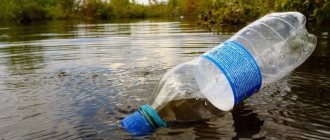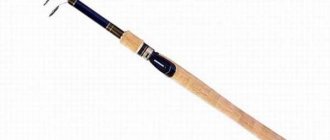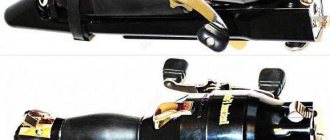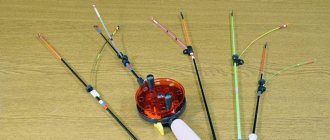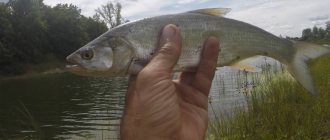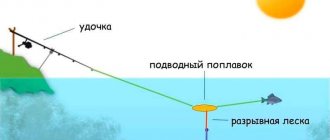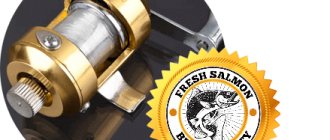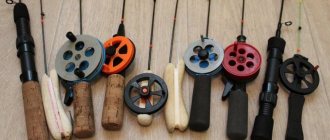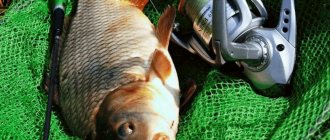Features of the bottom fishing rod
Bottom fishing rod A bottom fishing rod
is a baited hook used for fishing from the bottom or in the immediate vicinity of it. Bottom fishing rods, or casting rods (sometimes called casting rods), are usually equipped with heavy weights, which allows for long casting.
They are used for fishing from the shore, rafts, stationary boats on rivers and flowing reservoirs. Fishing in bodies of water without a current is less convenient due to the sag of the long line that is usually equipped with such fishing rods. When fishing in bodies of water without a current, slack in the line is eliminated with a counterweight attached to the line at the guard; when fishing in a current, its sagging is eliminated by the force of the current. Usually they use a rod 1 to 2 m long, with an elastic tip that can withstand a wide, energetic hook. Rods made from a whole juniper twig or combined rods - a bamboo butt with a juniper tip - have proven themselves well. The butt of the rod is sharpened or equipped with an iron spike so that it can be stuck into the ground, and reels, and the tip is equipped with a loop for securing the fishing line. When fishing with a reel, which is very convenient and advisable, 3-4 guide rings, a “tulip” ring and clamping rings for attaching the reel are installed on the rod. The usual length of fishing line is 25-30, and if there is a reel - 50 m. Thickness is 0.35-0.6 mm.
Components of a bottom fishing rod
- Rod.
Any rods are suitable. They must withstand the weight of the equipment when casting, so they take into account the test parameter. In calm waters with a test load of about 60 g, the length of the rod is more than 2 m. On large rivers - up to 140 g and 3 meters, respectively. - Fishing line.
You have to hunt with a bottom fishing rod in a variety of conditions; the main requirement for a fishing line is its versatility and ability to withstand the fight against large prey. For perch, roach, bream, crucian carp, silver bream and other fish that are not too large and not distinguished by fighting qualities, a fishing line with a diameter of 0.3-0.35 mm and a slightly thinner leash are quite suitable. For large fish, silicone fishing lines with a diameter of 0.35-0.50 mm are often used. The usual length of fishing line is 30-40 m. Using spinning gear in bottom fishing allows you to get by with a relatively thin fishing line, but it is wound on a spool or drum of a reel that is twice as large. - The sinker
is usually chosen drop-shaped, weighing up to 100 grams. The shape of the sinker is decisive when casting far, and its weight helps prevent the equipment from being carried away in strong currents. - Leads
for bottom fishing rods have a length of 10 to 50 cm and a thickness of one and a half to two times thinner than the main fishing line. The shorter the leash, the better, it gets less tangled. - Hooks
are chosen with the expectation of large fish - sharp, ensuring self-hooking. It's better to use doubles. When fishing with maggot or pearl barley, choose a short hook No. 10-14. A hook with a long shank No. 6-8 is suitable for a worm. - The bite alarm
notifies the angler that the fish is interested in the bait. Since several gears are often used simultaneously, and fishing is often carried out at night, an important part of the equipment is a bite alarm. The most common of them is a bell attached to the end of a fishing rod, with a niche for lighting. A vertically placed rod is also a good signal of a bite. - Float
. The equipment of a bottom fishing rod intended for fishing with live bait includes a float. It keeps the bait fish in a certain layer of water, and also prevents it from hiding in shelters. - Rod stand
. A necessary option is a stand for the rod. Sometimes it’s just a peg or a flywheel; when fishing on a river, a butt holder is needed. Racks can be single or triple.
Rod selection
One-handed and two-handed spinning rods are excellent as fishing rods for bottom tackle. They have all the necessary advantages, such as lightness, strength and practicality.
[THERE IS AN ANSWER] How to make a shock absorber for bottom tackle
You can also use longer telescopic rods, but they are less convenient and are better used in cases where you need to cast bait over long distances.
Choosing a rod for bottom tackle depends on the conditions in which you will have to fish. If during fishing you need to cast the bait at a distance of 20–30 meters, a light one-handed spinning rod will be enough, but if you have to cast the bait at a distance of 50 meters or more, in this case it is more advisable to use a longer rod.
You should also pay attention to the test and structure of the rod; you should select them based on the weight of the sinker (feeder), casting distance and the type of fish you intend to catch.
The rod test is the boundary between the minimum and maximum weight of the bait that can be cast using a given rod without overloading. These indicators are not a postulate and both lighter and heavier weights can be used.
However, in the case of a light weight, the casting range of the bait will be significantly reduced, and using a heavier load can even break the rod.
The action of a fishing rod is usually understood as the shape of the bend under load. Usually the system is divided into 4 types:
- Ultra-fast (only the rod tip works, no more than 1/4 of the rod length)
- Fast (bends approximately 1/3 of the length)
- Medium (rod bends about halfway)
- Slow (most of the rod bends, approximately 3/4)
The slower the action of the rod, the longer the cast you can make, but hooking with such a rod will be more difficult.
The most versatile is the medium action, with the help of such a rod you can cast the bait quite far and effectively hook it at a decent distance.
Also, if the tip of the rod is used as a bite alarm, in this case it is more advisable to use a faster action.
Coil selection
Choosing a reel for bottom tackle is not much different from choosing a reel for a float rod.
The best option would be a modern spinning reel, which can be easily purchased at any fishing store.
The main thing you should pay attention to is the amount of fishing line that the reel holds on the spool and the quality of manufacture of the product itself, it must be durable and free of defects.
Which companies should you prefer?
It depends on the amount you are willing to spend, you should not buy expensive models right away; inexpensive products from the Middle Kingdom are quite suitable for a start.
If you want to buy a good reel, then you should pay attention to the companies Shimano (Japan), Daiwa (Japan), SilverStream (Russia).
I think about the coils we can finish here.
Selection of fishing line, sinkers and hooks
Now let's talk about line, sinkers and bottom hooks.
When choosing a fishing line for a bottom fishing rod, you should consider the following factors: the fishing line should be strong, moderately elastic and as invisible as possible to the fish.
The thinner the line, the less noticeable it is for the fish, and accordingly there will be a greater number of bites, and accordingly, vice versa, the thicker the line, the fewer the number of bites.
The best option for a bottom fishing rod would be a regular monofilament line with a diameter of 0.15 to 0.35 mm, depending on the size of the fish you intend to catch.
The use of braided fishing lines in bottom gear is best avoided without justified reasons, since braided fishing line, unlike monofilament, although it has much greater strength, is more noticeable to fish, which reduces the number of bites. In addition, another feature of braided fishing lines is their greater tendency to tangle and form “beards,” which causes great inconvenience.
The most popular sinkers for bottom fishing rods are olives.
In general, the size and shape of the sinker should be selected based on the fishing conditions, if you are fishing on a pond or lake, without a current or it is very weak, in this case there is no point in using heavy sinkers. 1-2 small olives will be quite enough, which will easily allow you to throw the bait to the required distance.
If you are fishing on a river with a stronger current, you will need a heavier sinker so that the current does not carry away the bait, otherwise you will have to constantly transfer the tackle.
It is also good to use flat-shaped sinkers during currents, because when they sink to the bottom, they will have lower resistance to flow than, for example, a round olive.
As a sinker on a bottom fishing rod, you can use a feeder, which will simultaneously serve as both a feeder and a sinker.
The hook is one of the most important parts of the bottom tackle; it must be sharp and of the correct size, otherwise there will be a lot of slips and so-called empty bites.
It is desirable that the color of the hook be closer in tone to the color of the bait, although in practice it happens that this does not play a special role, and it certainly won’t be superfluous.
When buying hooks in a store, check them for the quality of sharpening and hardening of the steel from which they are made.
A good hook should not bend or break when you try to bend it.
To check how well the hook is sharpened, you can run its sharp part along the nail; if the hook scratches the nail with a slight force, then it is well sharpened, but if the tip simply slides without leaving a mark, it is better to discard such hooks.
Fishing with a bottom rod
Fishing with a bottom fishing rod When fishing with a bottom fishing rod, the nozzle is lowered to the bottom.
This position of the nozzle determines the name of the fishing rod. The bottom fishing rod is designed for fishing at night, or rather, from evening to dawn. At this time, fishing with it is more successful than during the day. Proper fishing with a bottom fishing rod is only possible if the river flow is calm and even. Usually they fish from a boat, raft, floating bridge, etc. After casting the bait, the current will straighten the line into almost one straight line from the bait to the bell, which with its weight will pull the line down, creating a slight bend in it. With the line in this position, even the weakest bite will be noticeably transmitted to the bell, which will quietly rise and fall, indicating that the fish is “touching” the bait. The bottom fishing rod is used when fishing at different depths, from one to several meters. The bottom at the fishing site should be free of holes. Before fishing, it doesn’t hurt to check the condition of the bottom. The best places for fishing will be places on the river in front of holes, behind rifts, near steep banks, etc.
For bottom fishing, they rarely use more than 3-4 fishing rods. When the bite is intense, it is more convenient to fish with 1 - 2 fishing rods. The best lines for a bottom fishing rod are nylon (vein) 0.30 - 0.35 mm, nylon and silk wicker No. 0. Such lines almost do not get tangled when casting, and less floating silt is deposited on them.
The bottom fishing rod has a line length that rarely exceeds 15 meters. If they are fishing with two rods or more, then the lines are made of different lengths, for example, 15, 14, 13 meters. This avoids tangling the line after casting. The indicated length may vary in one direction or another depending on the depth, strength of the current and other factors.
When fishing with a bottom fishing rod, it is quite easy to notice even a “cautious” bite that causes the bell to only smoothly rise and fall, not to mention one that makes the bell jump sharply and ring. Sometimes, when bitten, it does not jump up, but gradually but quickly rises upward from the fish pulling on the line; More often than not, ide takes this way.
The bottom fishing rod and the process of fishing with it have its own basic rules. One of them requires, at the very first vibration of the bell, to take the rod in your hand and move it away from the side of the boat, carefully lifting it up a few centimeters. This is done so that during a sharp bite the rod does not hit the boat and so that you can make a hook at any time.
Another rule: you can’t hook immediately after the first signs of a bite. The fact is that when fishing with a bottom fishing rod, the bait most often is whole crawlers, eels, etc.; A fish, as you know, cannot immediately take a bait of this size into its mouth, but swallows it gradually. Therefore, cutting should be done after a short delay.
It is difficult to indicate the exact moment of hooking when fishing with a bottom fishing rod. The bottom fishing rod suggests hooking when the hand feels a fairly strong pull or sharp and frequent jerks from the other end of the fishing line. After an unsuccessful hooking, it is necessary to inspect the nozzle and, if necessary, change it or correct it and cast it again. In the absence of a bite or in case of a weak bite, it is recommended to inspect the nozzle from time to time, for example, once every 20 - 30 minutes; as they say, do a “re-throw”, since sometimes the nozzle gets sucked in by floating silt, mucus or debris.
Lure
There are many bait options for bottom fishing. The main requirements are for the viscosity of the finished mixture. Only when the food is washed out for 5-15 minutes will a spot form on the bottom, attracting fish.
Depending on the type of fish, the composition of the bait and particle sizes are selected. For example, when catching large fish (carp, carp, chub, ide, bream), large food fractions must be in the bait, otherwise the trophy fish will not stay long at the feeding point.
On the contrary, when fishing for roach, crucian carp, and silver bream, it is better to use a finely dispersed mixture so that the fish does not become saturated quickly.
Baits and baits
Maggot, worm, corn, pearl barley are the most commonly used baits. Not all attachments and baits are suitable for fishing on a bottom with a feeder.
The main criteria for choosing bait are as follows:
- preferences and tastes of fish;
- ability to stay on the hook well.
- It is best to have several bait options when fishing to please the capricious fish.
Bottom baits:
- canned corn;
- worm;
- maggot;
- hominy;
- mastyrka;
- steamed pearl barley and wheat;
- barley shell;
- leeches;
- boilies.
Fishing
Small fish (ruff, perch, rotan) are pulled out as quickly as possible to avoid a possible snag. If a large fish lands on the hook, you must try to carefully and gently extinguish its first, usually the most desperate, jerks. Then try to move it from its place, tear it away from the ground in order to tire it out gradually in the overlying layers of water, without weakening the tension of the fishing line and giving it up with sharp pulls, bring the trophy to a landing net that was lowered into the reservoir in advance. If such a fish is removed from the water by hand, you need to take it from above, near the head, pressing its gill covers with your thumb and forefinger.
How to choose the best fishing rod?
Choosing the best fishing rod is largely determined by the method of fishing . Only in this case will you be able to assemble a balanced fishing rod and enjoy a good bite. Today, fishermen use the following methods to catch peaceful species of freshwater fish.
[THERE IS AN ANSWER] Which fishing rod is best for carp fishing
Fans of bottom fishing prefer feeders . These are composite rods of the plug type, which are equipped with interchangeable tips (quivertips). The rigid blank allows you to make long casts of feeders and baits. Thanks to the high sensitivity of the rod tip, the angler detects a bite.
One of the oldest proven gear is the fly rod . It allows you to quickly remove fattening fish . To complete such gear, a lightweight telescopic fly rod without guide rings and equipment with a loaded float are required.
To fish with a float away from the shore , match gear . The important elements of such a fishing rod will be a plug-type match rod with guide rings and a spinning reel. The tackle is equipped with a fairly large float and sinker.
For river fishing, gear is assembled based on a light Bolognese rod . Thanks to the guide rings and reel, you can enjoy jigging . Even trophy fish lose their caution when a tasty bait naturally swims past them.
The most accurate float rod today is the plug . Thanks to a long rod of 12-16 m, you can point bait to a spot , as well as use exceptionally elegant equipment. Despite the high cost of gear, the number of adherents of this fishing method is growing every year.
You select the length of the rod for float fishing depending on the chosen fishing location. Same with the type and test of the rod.
